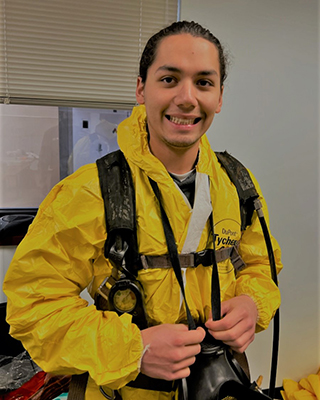Introduction

In the U.S., there are 574 federally recognized Tribes, and each has its own history, governance, and culture. There are also more than 100 state recognized Tribes.
NIEHS supports research to determine how environmental agents cause or exacerbate human diseases, including research to improve the environmental health of American Indians and Alaska Natives (AI/AN).
AI/AN people have long experienced lower health status when compared with other Americans, according to the Indian Health Service. Lower life expectancy and the disproportionate disease burden among Native peoples are broad quality of life issues rooted in economic adversity and poor social conditions.
In health-related studies, Tribes are increasingly influential and formative in research occurring in their territories. AI/AN people view health as a holistic construct encompassing physical, mental, emotional, social, and spiritual aspects of life.
What is NIEHS Doing?
Community-engaged Research and Citizen Science
At NIEHS, collaborations between researchers and citizens can take many forms.
Community-engaged research projects are when a scientific team engages a community to help develop research questions, design a study, and collect data.
Citizen science efforts are community driven and led. These projects may involve a research partnership with an academic or scientific institution. Through collaborative research, goals may be to translate findings into public health action that benefits the community.
Under this array of public engagement in scientific research, the NIEHS-supported Alaska Community Action on Toxics (ACAT) leads a collaborative project with researchers from several universities. It involves the Indigenous Yupik people of Sivuqaq (also known as St. Lawrence Island). There is concern about legacy pollutants from former military bases and other pollutants from global transportation systems that accumulate in the Artic. These chemicals may affect endocrine system functioning and child development in the current population. Their work is informing military base cleanup projects and development of health-related policies.
NIEHS Success Story: Protecting Arctic Communities (1MB) – This NIEHS translational research story shows how ACAT works with scientists to address health risks from contaminant chemicals. The ACAT team has used their research findings to inform local, state, federal, and international policies about toxic chemicals and protect people who are most likely to be affected.
The Sivuqaq collaborative is also conducting this project: Restoring Northeast Cape for the Health and Well-being of the Yupik Communities. Building on prior research, they are analyzing how and where people are exposed to pollutants and the resulting biological effects. The study is collecting data on levels of PCBs, organochlorine pesticides, and mercury in air, water, and traditional foods.

Another community-based participatory research project seeks prevention of paralytic shellfish poisoning in Southeast Alaska. The Sitka Tribe, in partnership with the University of Alabama at Birmingham and another community group, organized a program for environmental monitoring and seafood testing to reduce paralytic shellfish poisoning.
The Anishinaabe, a group of Tribal communities near the Great Lakes, have developed an interactive, culturally-tailored mobile application, called Gigiigooinaan (Our Fish). Their academic partner is the Medical College of Wisconsin.
The Ramapough Lunape Turtle Clan of northern New Jersey live near a 500-acre toxic waste site created by dumping industrial paint sludge. The New York University School of Medicine is partnering with this state-recognized Tribe to try to identify and implement safe farming practices and restore food sovereignty.
Based on prior findings, there is an urgent need to reduce arsenic exposure for Native Americans living in Arizona, Oklahoma, North Dakota, and South Dakota, who rely on private well water for drinking and cooking. Through community engagement, a study led by Johns Hopkins University will develop, pilot, and evaluate the effectiveness of an intervention to prevent arsenic exposure through drinking water in those communities.
The Northern Arapaho Tribe on the Wind River Reservation in Wyoming is concerned about possible environmental exposures in air, soil, plants, and water. In an exploratory study, researchers seek to characterize potential exposures using a citizen science approach, characterize related respiratory health outcomes, and examine the effect of conveying findings on changes to risk perception and behavior.

Capacity Building
NIEHS is working to strengthen the academic offerings and research ecosystem at Salish Kootenai College, a top Tribal college located in Montana, which serves Native Americans. The program is making students more competitive in advanced degree programs in the environmental health sciences and training people with unique environmental and community perspectives.
Ongoing NIEHS Grant Programs
Center Programs
The Environmental Health Science Core Center program enables research institutions to collaboratively tackle environmental health questions. These centers conduct scientific research, promote community engagement, advance translational research, and train new researchers. Several of the 20 Core Centers that NIEHS supports across the country address Tribal community issues.
The Centers of Excellence on Environmental Health Disparities Research program supports a center focused on Tribal environmental health disparities.
- University of Arizona – The Southwest Environmental Health Sciences Center focuses on understanding how the arid environment in the region, genetics, and the resulting toxicology influences the risk of human disease in underserved American Indian and Hispanic communities.
- Oregon State University – The Pacific Northwest Center for Translational Environmental Health Research builds research and stakeholder engagement capacity to help understand what people are exposed to in their homes, at their workplaces and in their communities, and to discover what hazards these exposures may pose to their health.
- Massachusetts Institute of Technology – The Center for Environmental Health Sciences studies the effects of environmental agents, individually and in combination, on human health and the health of the ecosystem. Their community engagement activities involve Native American populations in Maine, under-served communities in Boston, and towns in the industrialized Mystic River watershed.
- University of New Mexico - The Integrative Science Program Incorporating Research in Environmental Sciences supports several mechanistic, population-based, and community engagement studies that are focused on metals, mining, and mixtures. The center mostly works with Native American populations.
Superfund Research Program
The Superfund Research Program (SRP) provides practical, scientific solutions to protect health, the environment, and communities. SRP funds university-based grants on basic biological, environmental, and engineering processes. Within this program, Community Engagement Cores enhance knowledge exchange and support the needs of communities affected by hazardous waste. The following grant recipients engage with Native American communities or organizations.
- Columbia University – The Community Engagement Core partners with Tribal communities in North Dakota and South Dakota who have tainted drinking water from private wells and rural water systems. This population had urinary arsenic and uranium levels 2 to 5 times higher than other U.S. populations, likely contributing to a higher burden of cardiovascular disease.
- Massachusetts Institute of Technology – Working with Tribal educators (called Culture Keepers), this Community Engagement Core is co-creating and distributing hands-on experiential learning kits to teach key concepts of biology and environmental health to Tribal youth. Additionally, for the Passamaquoddy Tribe, this program is analyzing exposure to N-nitrosamines from industrial waste and potential harms to human health.
- Oregon State University – This Community Engagement Core identifies effective public health intervention and prevention strategies for dealing with polycyclic aromatic hydrocarbons (PAHs) and other harmful substances. They partner with the Swinomish Indian Tribal Community and the Confederated Tribes of the Umatilla Indian Reservation.
- University of Arizona – This program works with the Tohono O'odham Nation, Tohono O'odham Community College, the Navajo Nation, Diné College, and Navajo Community Health Representatives in communities that are disproportionately affected by mining and arsenic-contaminated water. This situation may result in higher rates of diabetes.
- University of New Mexico – This group uses Traditional Ecological Knowledge (TEK) and western scientific methods to increase understanding of the many ways people are exposed to hazardous wastes from abandoned uranium mines. They inform strategies to reducing human exposures to contaminants such as uranium, vanadium, arsenic, and other metals.
- University of Rhode Island – Researchers have a partnership with the Mashpee-Wampanoag Tribe to evaluate exposures to PFAS among Tribal members and to develop culturally specific risk-reduction strategies.

Worker Training Program
The Worker Training Program provides grants to labor-based health and safety organizations, academic institutions, and other nonprofit organizations to deliver health and safety training that prepares workers each year to handle hazardous materials and respond to disasters in their communities and nationally. Examples of programs that have served Native Americans and Alaska Natives are found in these states: Alabama (910KB), Alaska, Mississippi, New Mexico (827KB), New York (1MB), and Oregon. Additionally, a 2023 report (1.3MB) (1MB) summarizes WTP’s activities in training these populations.
Further Reading
Stories from the Environmental Factor (NIEHS Newsletter)
- Tribal Leaders Focus on Environmental Health, Data Sovereignty (August 2024)
- Understanding Mining’s Lasting Effects on Indigenous Communities (September 2023)
- On remote Alaskan island, community-based research empowers residents (January 2023)
- American Indian and Alaska Native safety, health training showcased (January 2023)
- Burning plastic can affect air quality, public health (August 2022)
- Tribal environmental health strengthened by NIEHS-funded scientist and her team (September 2022)
- Artist uses tribal symbolism, traditions to communicate science (November 2021)
- Water contamination on Tribal lands focus of webinar series (nih.gov) (August 2020)
Fact Sheets
Press Releases
- Reduced Blood Lead Levels Linked to Lower Blood Pressure in American Indians (January 11, 2024)
Podcasts
- Using Culturally Appropriate Messages to Promote Smoke-free Homes (2021) – To decrease tobacco use among Tribal populations, researchers must consider the culture and traditions of Tribal communities. NIEHS-funded researcher Patricia Nez Henderson, M.D., encourages smoke-free homes in Tribal communities, with the goal of improving their health.
Additional Resources
- Administration for Native Americans, Administration for Children and Families, U.S. Department of Health and Human Services – This office supports Native American communities by providing financial assistance and capacity building, sharing data, and advocating for improved policies across the federal government.
- Bureau of Indian Affairs, U.S. Department of the Interior – A federal agency almost as old as the U.S., its role has evolved to become a partner with Tribes to help them achieve goals for self-determination while maintaining relationships for how the federal government and Tribes conduct business with each other.
- Indian Health Service, U.S. Department of Health and Human Services - This agency provides a comprehensive health service delivery system for American Indians and Alaska Natives.
- Indigenous Health Collection, Environmental Health Perspectives – This collection of peer-reviewed journal articles, prepared in 2019, covers environmental exposures, health effects, and research considerations relevant to Indigenous populations, particularly in North America.
- NIH Tribal Health Research Office – This office seeks to ensure meaningful input from and collaboration with Tribal Nations on NIH policies, programs, and priorities. It coordinates Tribal health research activities at NIH.
- National Native American Heritage Month – Every November, NIH, along with many other federal agencies, explores the heritage, culture, and experience of Indigenous peoples historically and in American life today.






